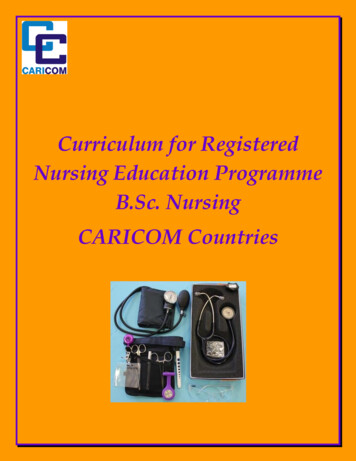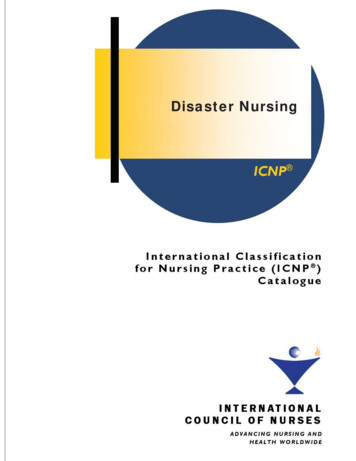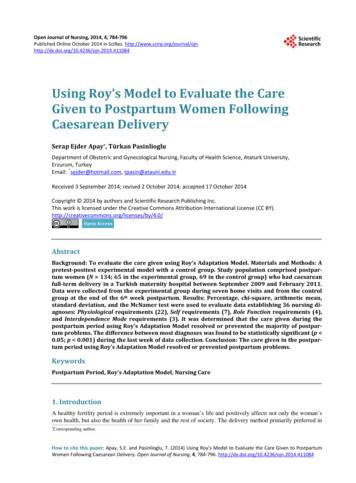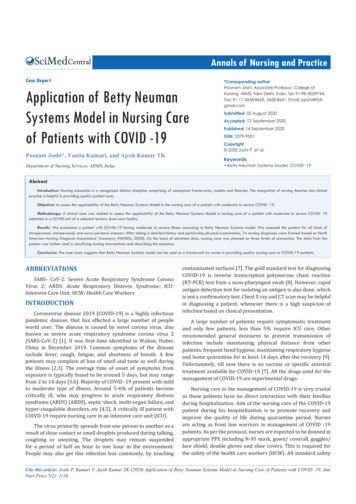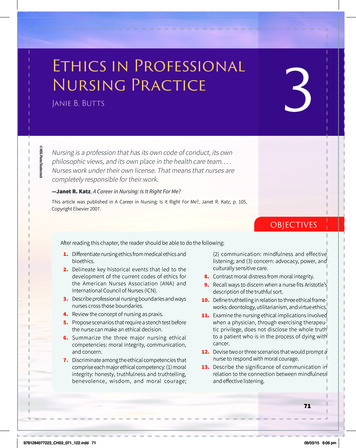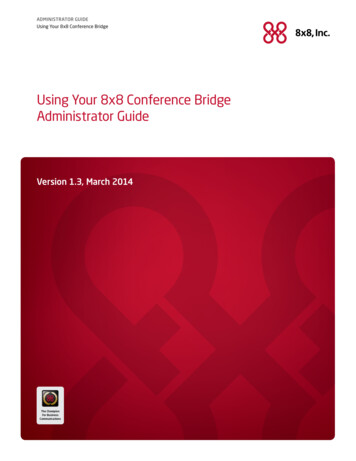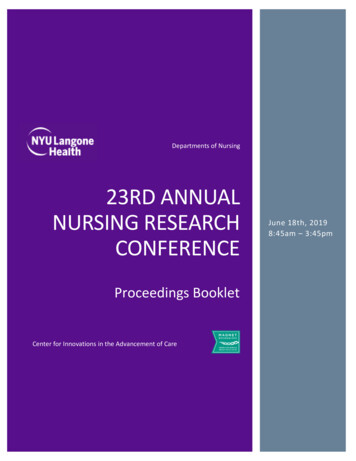
Transcription
Departments of Nursing23RD ANNUALNURSING RESEARCHCONFERENCEProceedings BookletCenter for Innovations in the Advancement of CareJune 18th, 20198:45am – 3:45pm
TABLE OF CONTENTSKeynote Presentation .2Morning Panel .3Poster Presentations .4Lunch Roundtables .32Afternoon Session – 1 .33Afternoon Session – 2 .37List of Sponsors .41List of Presenting Institutions .42Center for Innovations in the Advancement of Care .43Special Thanks .441
KEYNOTE PRESENTATIONNursing’s Role in Improving Health Outcomes Following Disasters and Major Public HealthEmergenciesTener Goodwin Veenema, PhD, RN, MPH, MS, FAANProfessor of Nursing and Public HealthJohn Hopkins School of NursingJohn Hopkins Bloomberg School of Public HealthDr. Veenema is a nationally recognized expert in disaster nursing and as CEO of the Tener ConsultingGroup, LLC, she has served as Senior Scientist to numerous federal agencies. An accomplishedresearcher, Dr. Veenema is a member of the American Red Cross National Scientific Advisory Board andan elected Fellow in the National Academies of Practice, American Academy of Nursing and the RoyalCollege of Surgeons, Dublin, Ireland. She is the editor of Disaster Nursing and Emergency Preparednessfor Chemical, Biological and Radiological Terrorism and Other Hazards, 4th Ed., the leading textbook inthe field, and Disaster Nursing, an innovative technology application (“App”) for the I-phone and I-pad(Unbound Medicine). Dr. Veenema was awarded the Florence Nightingale Medal of Honor (InternationalRed Crescent, 2013) the highest international award in Nursing. She received a Fulbright U.S. ScholarAward (2017) and currently serves as the 2017-18 Distinguished Nurse Scholar-in-Residence at theNational Academy of Medicine.2
MORNING PANELModerator: Ranekka Dean, PhD, RN, CIC, FAPIC – Director, Infection PreventionNYU Winthrop HospitalNurse Emergency Preparedness and Recovery: Lessons from New York CityEmergency Preparedness Training for Hospital Nursing StaffWilliam Lang, MSBill Lang is the Director of Hospital Readiness and Health Care Coalitions at the NYC Department ofHealth and Mental Hygiene. A former hospital administrator, Bill’s work in emergency preparedness atthe Health Department has gained him a reputation for expertise in “surge”. Over the years, he hasworked closely with NYC hospitals to develop practical disaster planning and response tools, which havebeen compiled into the Patient Surge in Disasters: A Hospital Toolkit for Expanding Resources inEmergencies. More recently, Bill was tasked with developing a health care coalition structure for NYCthat would strengthen the resiliency of the health care system for future disasters and allow forcontinuity of service during a public health emergency. Bill has a Masters in Health Policy andManagement from The Robert F. Wagner Graduate School of Public Service at New York University.Jeffrey Schlegelmilch, MPH, MBAJeff Schlegelmilch is the Deputy Director for the National Center for Disaster Preparedness at ColumbiaUniversity’s Earth Institute. In this role he oversees the operations and strategic planning for the center.He also oversees projects related to the practice and policy of disaster preparedness. His areas ofexpertise includes public health preparedness, community resilience, and the integration of private andpublic sector capabilities. Prior his role at Columbia, he was the Manager for the International and NonHealthcare Business Sector for the Yale New Haven Health System Center for Emergency Preparednessand Disaster Response. He was also previously an epidemiologist and emergency planner for the BostonPublic Health Commission. He holds a Master’s degree in Public Health from UMASS Amherst in HealthPolicy and Management, and a Master’s degree in Business Administration from Quinnipiac University.Disaster Planning and Recovery: Lessons Learned from Hospital Evacuations and RN DeploymentsRonald Keller, PhD, MPA, RN, NE-BCRonald Keller earned a BS in nursing from the University of Buffalo, a MA in Public Administration fromNew York University, and a PhD from the Rory Meyers College of Nursing at New York University. He is acertified nurse executive and critical care alum. He started his nursing career at NYU Langone Health in1987 as a clinical nurse and transitioned into leadership early in his career. He is currently the SeniorDirector of Nursing for Cardiac and Surgery, and Respiratory Care Services. Ronald is recognized as astrong leader and mentor. His success has come from the development of others and creating asupportive and healthy work environment. He has given several poster and oral presentations atnational conferences and co-authored articles in a peer reviewed journals.3
POSTER PRESENTATIONSPoster Number 1A2B: A Systematic ApproachElaina Weldon, MSN, ACNP-BC*; Lynette Lester, BS; Kristine Jaye Adalla-Angeles, BSN, RN; Nicole Ali, MDBackground: Over 100,000 people are awaiting life-saving kidney transplantation. A major criterion fortransplantation is blood type. Patients with ABO-B have among the longest wait times for kidneytransplantation, which largely represents an underserved population--minorities. Our TransplantInstitute oversaw 403 waitlist patients at the time of this project; 83 were listed as ABO-B. The newkidney allocation system (2014) highlights kidney transplantation by blood type; specifically, A2,commonly referred to as A, non-A1 kidneys to ABO-B recipients. Given the complexities of thetransplantation waitlist, a multifaceted approach was necessary to implement the A2B process.Purpose: Kidney transplantation allows for over 17,000 (2014) people to be transplanted annually. A2Btransplantation offers an additional donor pool for ABO-B .Methodology: We created a multidisciplinary team inclusive of a Transplant Nephrologist, NP, WaitlistRN, Waitlist Coordinator Assistant and Medical Student to review the patients who were ABO-B on ourwaitlist. Of those patients we identified 4 groups: 1) consented to receive blood type A2 organs withtyping, 2) consented to receive blood type A2 and never been tested or testing was outdated, 3)received typing before a consent was implemented, and 4) never educated on receiving an A2 kidney.We determined the appropriate cutoff was a titer of 1:16.Results: Twenty-nine patients had previously consented to receive blood type A2 organs and had typingperformed--no intervention was needed. Fifteen patients previously consented to receive blood type A2kidneys but never had titers performed. These patients were sent to our lab for testing. Twelve patientson the waitlist who had typing performed previously but never provided consent, were educated aboutA2 kidneys and consented if agreeable. Nineteen patients had neither received education nor hadtesting performed. These patients were contacted, educated and if agreeable--tested. Once consented,patients who had titers less than 16 had their status updated in UNet to accept A2 organ offers.Additionally, we identified ten patients with recent consents and titers using this process. Using asystematic approach, we were able to convert 34 ABO-B patients to be listed for A2 kidneys.Conclusion / Implementation for Practice: Centers should work with their existing blood bank to offerthis additional avenue for ABO-B waitlist patients. Consideration should be taken for patients already onexisting waitlists to be educated, consented, and tested. A multidisciplinary approach proved to create astreamlined process.*NYU Langone Health4
Poster Number 2An exploration of nursing students' experiences with SBAR in the clinical settingRoxanne Sabatini, MSN, RN-BC*Background: Clinical communication is a contributing factor for safe patient care and linked to theenculturation of nursing students transitioning to practice. Structured communication, such as SituationBackground-Assessment-Recommendation (SBAR), is utilized in healthcare to improve emergency careand handoff communication. Prior studies focused on educational strategies to facilitate nursingstudents’ use of SBAR within academic settings. There remains a limited focus on nursing students’experience using SBAR within the clinical learning environment.Purpose: Focused clinical communication is an essential skill for newer nurses to escalate patient careneeds. The purpose of a qualitative inquiry was to gain a better understanding of students’ experienceusing the SBAR mnemonic within the clinical setting.Methodology: The qualitative research study utilized in-depth, semi-structured interviews with nursingstudents who met inclusion criteria. A purposive sample of eleven associate degree nursing studentswho had recent experience in the use of SBAR were recruited from colleges in the tristate area of NewYork, New Jersey, and Pennsylvania. Semi-structured interviews were conducted using a field-testedinterview protocol. Audio-recorded interview data and researcher field notes were transcribed manuallyand analyzed using three levels of data analysis concurrent with data collection. Participant memberchecks confirmed the findings and themes that emerged through data analysis.Results: Participants shared the benefits and challenges encountered in the use of SBAR within theclinical learning environment. Nursing students in the study perceived SBAR as a powerful tool tostructure their clinical communication. Participants all struggled with organizing and prioritizing the datato include in the SBAR communication and cited anxiety and inexperience as significant barriers. Nursingstudents used various resiliency and learning strategies to overcome these challenges to negotiate theirrole within the clinical setting. Participants recommended early introduction and practice in the use ofSBAR to improve their skills and to gain confidence in its use.Conclusions / Implications for Practice: Participants in this study suggested that nursing colleges shouldintroduce SBAR use early in their programs and provide multiple opportunities for practice. Clinicalfaculty and preceptors should encourage SBAR use and provide feedback to students and novice nursesto facilitate clinical communication self-efficacy.*Morristown Medical Center5
Poster Number 3An Interdisciplinary Approach to Preventing Tracheostomy-Related Pressure Injuries Across A HospitalNetworkAnne E. Urquhart, MS, APRN, AGCNS-BC, CCRN, CMC*; Elizabeth Savage, MSN, APRN, ACNS-BC, CWON,IIWCC-NYU, DAPWCABackground: During the first quarter of 2018, NYU Langone Health System had a rise in tracheotomyrelated pressure injuries (TRPI) across all campuses and patient populations. In Q1CY2018, there were atotal of 7 TRPI, which was double the amount of injuries compared to Q1CY2017 (n 3).Purpose: To establish an interdisciplinary team to standardize physician practice for tracheostomyinsertion and nursing practice for the care of patients with tracheostomies. The secondary goal was toreduce our TRPI incidents to zero in Q3 & Q4CY2018.Interventions / Outcomes: 1. Formation of the Airway Steering Committee - evaluates all TRPI cases toidentify areas for improvement and acts as a centralized interdisciplinary escalation pathway for alldeviations in practice 2. Standardization of physician practice: - Use of a protective foam dressing Guidelines for suture tightness - Guidelines for interventions during the first 7 days after tracheostomyplacement 3. Standardization of nursing practice: - Nursing Protocol and Procedure standard revised anddeveloped to reflect best practice - Nursing educational tools created to provide ongoing education forthe care and management of trached patients (e.g. trach care video, nursing trach care Competency)4.Tracking and Monitoring (e.g. Daily trach report, updated EHR documentation for trach careinterventions, ACA).Outcome Measures / Results: Tracheostomy-related pressure injuries have shown a consistentdownward trend in our quarterly reported TRPI's since the interventions were implemented.Conclusions: Successfully created cross-campus interdisciplinary team to tackle a enterprise-wideproblem to decrease harm. Next steps: Interdisciplinary trach rounding team to provide real timeeducation and oversight at the bedside. Nursing live observational audits. Otolaryngology provider ledQI project.*NYU Langone Health6
Poster Number 4Beyond the Course Objectives: An Interprofessional Education Pilot StudyAkhtar Ebrahimi Ghassemi, PhD, MHC, MSN, RN*; Renee Fabus, Ph.D., CCC-SLP, TSHHBackground: Despite the complexity of patient care and promise of interprofessional collaboration inhealth professional educational programs, interprofessional education (IPE) and practiceimplementation challenges exist. Interprofessional education is a collaborative approach to develophealth care students as future interprofessional team members and a recommendation suggested byInstitute of Medicine. The World Health Organization (WHO, 2016) recognizes the need for collaborationamong health care professionals in both education and clinical practice. Interprofessional education isan ideal vehicle for introducing new content areas to preprofessional students; for example, “in 20092010 academic year 2726 nursing and medical students participated in one or more interprofessionaleducational courses related to quality improvement or patient safety (Dacey, Murphy, Anderson, &McCroskey, 2010).Purpose: The aim of this pilot study was to increase the knowledge of students regarding the roles andresponsibility of nurses and speech pathologists (SLPs) in the assessment and intervention of dysphagia.Materials and Methods: A pilot study with a nonequivalent comparison before/ after design wasconducted to examine undergraduate students’ and graduate students’ knowledge of the role of nursesand speech-language pathologists (SLPs) while working with patients diagnosed with dysphagia. Allstudents received pre- and post-tests assessing their knowledge of the respective profession.Results: A repeated measure of analysis of variance using pre- and post-tests by group design revealed astrong and statistically significant main effect from pre‐ to post‐testing, F (1, 19) 17.42, P 0.001, andpartial η2 0.48.Conclusion: The results indicated that students received higher scores on post-tests. This studyreinforces the importance of collaboration of healthcare professionals during their professionalcoursework. Interprofessional education should be a major focus of university programs training futureprofessionals to ultimately enhance the quality of patient care. Students who have participated in IPE(for example, those in this study), say it leads to increased knowledge of other disciplines and createsopportunities to consult with members of different professions (Beassler, Best, & Sexton, 2016). Futureresearch should further explore IPE using an interprofessional simulation experience model or acommunity-based experience model.*Hartwick College7
Poster Number 5Evaluating the Impact of an Oral Care Initiative in an Academic Medical CenterDora H Castillo MA, RN, CCRN*; Daniel J. Smith MA; Peri Rosenfeld, PhDBackground: Nursing interventions in oral hygiene are important for health promotion and illnessprevention, particularly in acute care facilities. Oral health care in the acute care settings is oftenoverlooked. In the literature, there is strong evidence that supports the link between poor oral health andpneumonia and systemic infections in the hospitalized patient. Prior to 2006, institutional guidelines didnot exist for oral assessment or oral care interventions. In 2008, a nurse-led Oral Care Council was createdat this academic medical center to review the institution’s oral care practices and introduced evidencebased guidelines. Since the inception of the peer-to-peer model in 2006, on-going training and refresherclasses have been provided routinely to ensure that new RNs learn about and veteran RNs remain currenton oral health practices.Purpose: Evaluate the oral health documentation and effectiveness of the oral health program.Methodology: For this retrospective quality Improvement study, we used a sample of all inpatients whowere admitted to the AMC over the three-month period from October 1 through December 31, 2017, andwho were at least 1 year of age. Only a patient’s first admission in that time frame was obtained for thedata set; all recurring admissions were excluded.Results: The sample consisted of 13,303 patients. Analysis of oral health assessment data from EHRsindicated that RNs were highly compliant in their documentation of patient oral health risk. We foundgreater than 95% compliance with oral care documentation at admission and discharge, suggesting strongcompliance with the oral health guidelines and that the intervention improved patients’ oral health,especially those with moderate or severe dysfunction.Conclusions / Implications for Practice: Important lessons were learned in launching and implementingthe oral health initiative at this AMC, which can be grouped into two broad categories: (i) the value ofcreating and sustaining an effectual Oral Care Council, and (ii) the institutional resources necessary tomaintain and monitor oral health practices throughout the institution. The nurse-led oral care initiativestandardized oral assessment and care practices have improved outcomes in patient oral health. TheCouncil aimed to raise awareness of the importance of oral health as a risk factor for the hospitalizedpatient, and it has been able to change the culture of the institution on oral health practices.*NYU Langone Health8
Poster Number 6Evidence-Based Strategies for Maintaining Zero Ventilator-Associated Events (Pneumonia) in theMedical Intensive Care Unit (MICU)Amarachukwu Egbujor RN, MSN*; Opal Martin RN; Jacqueline Boyd RN, MSN; Genevieve Watson-Grey, RN,MSABackground: Ventilator-associated event (pneumonia) is one of the most commonly encountered hospitalacquired infections in intensive care units and is associated with increased morbidity, mortality, and costsof care. There was an increase, in VAEs (pneumonia) in the MICU from 2005-2008. In 2005, the VAE ratewas 12.1, which was three times greater than the national average of 3.6 (NHSN).Purpose: Reduce the occurrence of ventilator-associated events (VAEs), pneumonia in the MedicalIntensive Care Unit (MICU) to below the National Health Safety Network (NHSN) mean of 3.6.Methodology: An interprofessional quality improvement team of critical care nurses, clinical pharmacists,physicians, Nurse Educator, and Performance Improvement staff performed a gap analysis, implemented,and evaluated an evidence-based protocol for prevention of VAE (pneumonia) in the MICU. The teamconducted a retrospective chart review, implemented, and evaluated evidenced-based interventions toreduce ventilator-associated pneumonia (VAP) using a Mechanically Ventilated Patients (MVP) Bundle: 1.Deep vein thrombosis (DVT) prophylaxis 2. Head of bed elevation above 30 degrees 3. Oral care protocol 4.Stress ulcer prophylaxis 5. Sedation management including daily wake up 6. Spontaneous breathing trials7. Fluid conservation to avoid pulmonary complications 8. Daily huddles to review care of ventilatedpatients.Results: Since the implementation of the MVP Bundle in 2005, the MICU has sustained a rate of zero (0)VAE (pneumonia).Conclusion / Implications for Practice: The existing evidence-based MVP Bundle is suited for improvingoutcomes for mechanically ventilated patients. With the interprofessional team working collaboratively,zero occurrences of ventilator-associated pneumonia are sustainable in the MICU.*SUNY Downstate Medical Center-University Hospital of Brooklyn9
Poster Number 7Evidence-Based Strategies for Successful Reduction in Catheter-Associated Urinary Tract Infections(CAUTI) Hospital-Wide: Nurse-Driven Protocol for Catheter RemovalJean McHugh, PhD, RN, APRN-BC*Background: CAUTIs are the most common hospital-acquired infections and are associated with increasedlength of stay, excessive costs of care, patient discomfort, and at times mortality. CAUTIs are a reasonablypreventable complication of hospitalization. The duration of an indwelling urinary is directly related to riskfor the development of CAUTIs. Despite the implementation of evidence-based CAUTI preventionstrategies hospital-wide (insert urinary catheters only for appropriate CDC indications, sterile insertiontechniques, daily maintenance care), CAUTI rates remained high. To address this problem, an evidencebased Nurse-Driven Protocol for Removal of Indwelling Urinary Catheters was developed and implementedto reduce the number of urinary catheters, as well as, reduce the number of catheter days.Purpose: Decrease the number of indwelling urinary catheters (Foley) hospital-wide, and in turn, reducethe occurrence of catheter-associated urinary tract infections (CAUTI) and prevent avoidable harm.Methodology: The Nurse Infection Prevention and Control Champion developed the evidence-basedNurse-Driven Protocol for Removal of Indwelling Urinary Catheters. An Interprofessional QualityImprovement Team worked to implement and evaluate the Nurse-Driven Catheter Removal Protocolhospital-wide in an academic medical center: 1. Nurse-Driven Protocol for Catheter Removal is linked tophysicians’ insertion catheter order in the patient electronic health record. A physician renewal order isrequired every 24 hours. 2. Physician required to document indwelling urinary catheter insertion criteria.3. Within 24 hours, RNs remove urinary catheters that do not meet the insertion criteria without aphysician’s order (if there are no known contraindications to the removal). 4. RNs implement alternativemethods to Indwelling urinary catheters post catheter removal.Results: Since the hospital-wide implementation of the Nurse-Driven Protocol for Catheter Removal, weachieved a Standardized Infection Ratio (SIR) of 0.8, well below 1.0 for CAUTI.Conclusion / Implications for Practice: The existing evidence-based Nurse-Driven Protocol for CatheterRemoval is suited for reduction in urinary catheter use, and ultimately a reduction in CAUTI rates. With theinterprofessional team working collaboratively, CAUTI reduction is sustainable.*SUNY Downstate Medical Center-University Hospital of Brooklyn10
Poster Number 8First Year Program Implementation Plan (PIP) of a 5-year Hospital System Based Network of HealthPromotion ProgramsTaryn De Sio-Garber, MS*; Peri Rosenfeld, PhD; Kimberly S. Glassman, PhD, RN, NEA-BC, FAANBackground: Interest in health promotion, defined by the World Health Organization (2018) as “theprocess of enabling people to increase control over the determinants of health and thereby improvingtheir health,” is changing perceptions of prevention, patient education and access to care. Launched atNYU Langone in 2018, the Lerner Health Promotion initiative seeks to integrate health promotionprograms into an integrated multi-hospital system, a setting that typically focuses on acute care. Longterm planning for this initiative requires explicit evidence-based planning effort that utilize implementationscience frameworks, tools, and models.Purpose: Key objectives of the initiative are to: 1) develop a 5 year implementation plan that aligns andbuilds upon current programs within the hospital system; 2) increase the awareness among patients andstaff the benefits of tobacco cessation, integrative health, and lifestyle modification and 3) integratecommunity, worksite, and disease specific, health promotion models and tools to produce synergisticrelationship across hospital system health promotion programs, (4) introduce new programing to addressidentified areas.Methodology: Thus far, program planning and implementation for the Lerner Health Promotion initiativeencompasses multi-methods including: 1) comprehensive review of evidenced based health promotionmodels and tool; 2) identification of appropriate implementation models; 3) formative, systematicinterviews with panel of content experts; 4) frequent meetings with interdisciplinary teams; and 4)integrating systematic evaluation plan for all stages.Results: Early efforts have identified four fertile areas for immediate implementation and evaluation ofoutcomes: (i) Tobacco Cessation efforts for targeted staff and patients; (ii) expansion of Integrative Healthservices to multiple locations; (iii) introduction of unique health promotion education/activities for RNse.g. self-care app; (iv) implementation of weekly cardiac rehabilitation health promotion electronicmessage pilots to address the decreased attendance in-person education. Effective planning methodsaccelerated approval of five-year plan and preliminary results from data collected from employee self-careapp and a cardiac rehabilitation electronic message pilots have been positive. Complete data analysis ofthese innovations are expected in fall 2019.Conclusions / Implications for Practice: Building evidence-based practices and principles ofimplementation science can improve program development and implementation and accelerate theintroduction of new initiatives.*NYU Langone Health11
Poster Number 9HepCare Engagement and Linkage to Hepatitis C CareKristyn Pierce, B.S.*; Mary Olson, DNP, RN, PMHCNS-BC, ANP-BCBackground: In 2013 the New York State Department of Health issued a law requiring that all hospitalinpatients and primary care outpatients born between 1945-1965 be offered screening for HCV. 1 The U.S.Preventive Services Task Force recommends screening for HCV in persons at high risk of infection as well asone time screening in person born between 1945-1965. 2 One study noted that the inpatient HCVscreening rate was only 22%, and 60% of patients who screen HCV positive do not link to care. 3 Withimproved HCV treatment regimens and sustained viral response rates of 90%, there will be anopportunity to decrease mortality in this population.Purpose: To identify barriers for linkage and engagement in HCV care.Methodology: A retrospective chart review was conducted to determine rates of linkage and engagementin care for patients that screened positive for HCV. Null hypothesis: relative proportions of patients beinglinked to HCV care are independent of whether or not they have a psychiatric diagnosis. (In other words,patients are equally likely to be linked to care regardless of psychiatric disorder) Alternative hypothesis:There is a significant difference in proportions of patients being linked to HCV care, explained by whetheror not they have a psychiatric diagnosis. n 50 patients with a positive HCV RNA between 8/1/17-8/1/18who have never been seen before for HCV and have 1 year life expectancy 2 dichotomous variables usedin analysis: Linked to care? Yes No Psychiatric diagnosis: Yes No Type of analysis conducted: Fisher’s exacttest of independenceResults: Tab linked psych, exact Psych Linked No Yes Total No 6 11 17 Yes 24 9 33 Total 30 20 50 Fischer’sexact 0.015 1-sided Fisher’s exact 0.012 Since Fisher’s exact p-value 0.05, we can reject the nullhypothesis and conclude that there is a statistically significant difference between those who havepsychiatric diagnoses and who do not in terms of linkage to care.Conclusion: Patients with a psychiatric diagnosis are less likely to link and engage in HCV care afterscreening positive for HCV. Models of care to increase linkage and engagement of psychiatric patients inHCV care are needed.References:1. Shah, N. New York State Department of Health Hepatitis C Screening Law. 10/23/2013.2. US Preventative Services Task Force. Screening for Hepatitis C Virus Infection in Adults. Annals ofInternal. Retrieved from www.annalsofinternalmedicine.org3. Assoumou, S., Huang, W., Horsburg, C., et. al., Relationship between Hepatitis C Clinical Testing Stie andLinkage to Care. Open Forum Infectious Disease, 20144. ASLD, IDSA, HCV Guidance: Recommendations for Testing, Managing, and Treating Hepatitis C,retrieved from http://www.hcvguidelines.org*NYU School of Medicine12
Poster Number 10Implementation of Evidence-Based Practices to Decrease Central-Line Associated Blood Stream Infection(CLABSI) in the Medical Intensive Care Unit (MICU)Nyasha Cupid RN, MSN*; Allan Abique RN, BSN; Genevieve Watson-Grey RN, MSABackground: MICU provides care to a diverse population of critically ill patients who often require centralvenous catheters (CVC) to improve their outcome. Patients with CVCs are at risk for CLABSI due tocontamination and colonization of CVC devices by microorganisms. In 2015, NYSDOH reported 130 (0.97%in NYS) cases of CLABSI, which included 11 cases from the MICU (6.6% hospital-wide). During that time,MICU had a cluster of pathogens that included Carbapenem-Resistant Enterobacteriaceae (CRE) andAcinobacter. Elimination of CLABSI is an organizational patient safety priority because it is attributable topotentially life-threatening complications associated with increased length of hospital stays, higher cost oftreatment and increased morbidity and mortality rates.Purpose: Decrease the incidence of
researcher, Dr. Veenema is a member of the American Red Cross National Scientific Advisory Board and an elected Fellow in the National Academies of Practice, American Academy of Nursing and the Royal College of Surgeons, Dublin, Ireland. She is the editor of Dis


